Chapter 8: Technology and production
Short Answer Questions
Answer: It is a schedule that shows the highest level of output the firm can produce from a given combination of inputs.
Answer: A technology exhibits constant marginal returns when there is a range of input levels over which the marginal product of a factor remains unchanged as the amount of the factor used increases.
Answer: It is the rate at which the available technology allows the substitution of one factor for another. It is -1 times the slope of the isoquant.
Answer: It will increase by less than two times.
Answer: Marginal returns are input-specific, in the sense that they reflect the impact of a change in the amount of a single factor. The degree of returns to scale, on the other hand, concerns the impact of a simultaneous change in all factors in proportion on the level of output produced.
For the remaining questions support your answers with the aid of appropriate diagrams.
Answer: If the factors of production (for example, petrel and gasohol) are perfect substitutes, they exhibit a constant marginal rate of substitution. As a result, the resulting isoquants are straight lines.
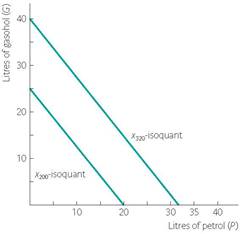
Answer: The number of input X is measured on the horizontal axis, and the number of input Y is on the vertical axis. When two inputs must be used together in a constant proportion, that is no factor substitution is possible, the isoquants are right angles that are placed along a ray from the origin.
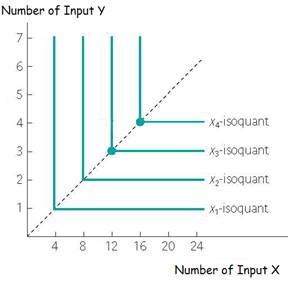
Answer:
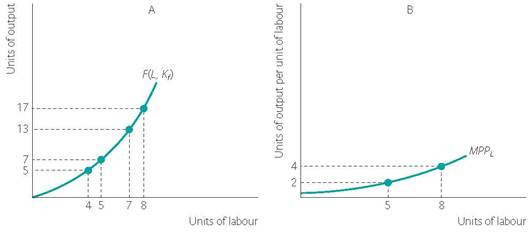
The slope of the total product curve is the marginal physical product of labour. When the firm’s technology exhibits increasing marginal returns to labour, the total product curve gets steeper as we increase the quantity of labour, and the marginal physical product curve is upward sloping.
Answer:
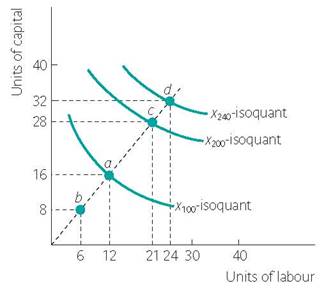
When the firm doubles its inputs from using 12 units of labour and 16 units of capital to using 24 units of labour and 32 units of capital, It rises output more than doubles from 100 units of output to 240 units.
Answer:
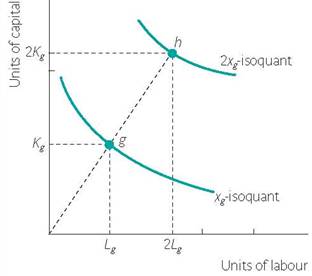
Starting at point g on the ![]() -isoquant, the firm double its input levels from
-isoquant, the firm double its input levels from ![]() units of labourand
units of labourand ![]() units of capital to 2
units of capital to 2![]() units of labourand 2
units of labourand 2![]() units of capital, the amount of its output doubles, increases to point h on the 2
units of capital, the amount of its output doubles, increases to point h on the 2![]() -isoquant.
-isoquant.
Essay questions
Brief answer: Yes, for instance, consider an increase in the amount of labour employed in a factory. At low levels of labour, the workers would have difficulty operating the machines and ensuring a smooth flow of work through the assembly process. Starting with just a few workers, added numbers can have a larger and larger incremental effect on total product. That is, the marginal returns to labour increase. At some point, however, the usefulness of more workers starts to decline. The plant eventually has more workers than can be used on the production line, because only so many people can work with a given piece of machinery. Once that point is reached, additional workers do not make much of an incremental contribution to total output.
In other words, diminishing marginal returns to labour set in.
Brief answer: The two factors of production are said to be perfect substitutes when they exhibit a constant marginal rate of substitution. The resulting isoquants are straight lines. If the two inputs can always be substituted for each other in the production process on a one-for-one basis, the firm will decide to spend their budget on the cheaper inputs only.
Brief answer: Assume that labour is a variable factor for National Motors and robots are fixed. Suppose that National Motors has 200 robots installed and wants to produce 160 cars per day beginning next week. To produce 160 cars per day, the firm chooses among the input combinations lying exactly on the x160-isoquant. Since in the short run the firm’s level of capital is fixed, its input decision consists of making sure it hires just enough labour to produce the desired output. Consequently, the only available input combination on the x160-isoquant is 1,000 workers per day and 200 robots per day. In the long run, however, both labour and robots are variable, so the firm can choose from among any combination of the two that can produce 160 cars per day. The set of feasible input combinations is now given by the entire x160-isoquant.
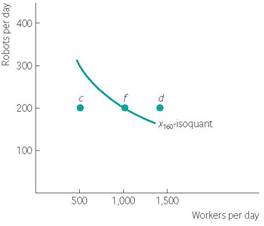
Brief answer: When two inputs must be used together in a constant proportion that is only one tractor driver is required to drive one tractor, the isoquants are right angles that are placed along a 45 degree line from the origin.
Brief answer: To hold its total output level constant, the firm must choose ΔL and ΔK so that (MPPL x ΔL) just offsets (MPPK x ΔK) or (MPPL x ΔL) + (MPPK x ΔK) = 0.
The equation can be rewritten as ![]() .
.
Now recall that −ΔK/ΔL is the marginal rate of technical substitution. Hence, it tells us that![]() .
.
In words, the marginal rate of technical substitution between two inputs is equal to the ratio of the marginal physical products of the inputs.
Source: http://highered.mheducation.com/sites/dl/free/0077121775/668802/CH8_PracticeExam.doc
Web site to visit: http://highered.mheducation.com/
Author of the text: not indicated on the source document of the above text
If you are the author of the text above and you not agree to share your knowledge for teaching, research, scholarship (for fair use as indicated in the United States copyrigh low) please send us an e-mail and we will remove your text quickly. Fair use is a limitation and exception to the exclusive right granted by copyright law to the author of a creative work. In United States copyright law, fair use is a doctrine that permits limited use of copyrighted material without acquiring permission from the rights holders. Examples of fair use include commentary, search engines, criticism, news reporting, research, teaching, library archiving and scholarship. It provides for the legal, unlicensed citation or incorporation of copyrighted material in another author's work under a four-factor balancing test. (source: http://en.wikipedia.org/wiki/Fair_use)
The information of medicine and health contained in the site are of a general nature and purpose which is purely informative and for this reason may not replace in any case, the council of a doctor or a qualified entity legally to the profession.
The following texts are the property of their respective authors and we thank them for giving us the opportunity to share for free to students, teachers and users of the Web their texts will used only for illustrative educational and scientific purposes only.
All the information in our site are given for nonprofit educational purposes
The information of medicine and health contained in the site are of a general nature and purpose which is purely informative and for this reason may not replace in any case, the council of a doctor or a qualified entity legally to the profession.
www.riassuntini.com